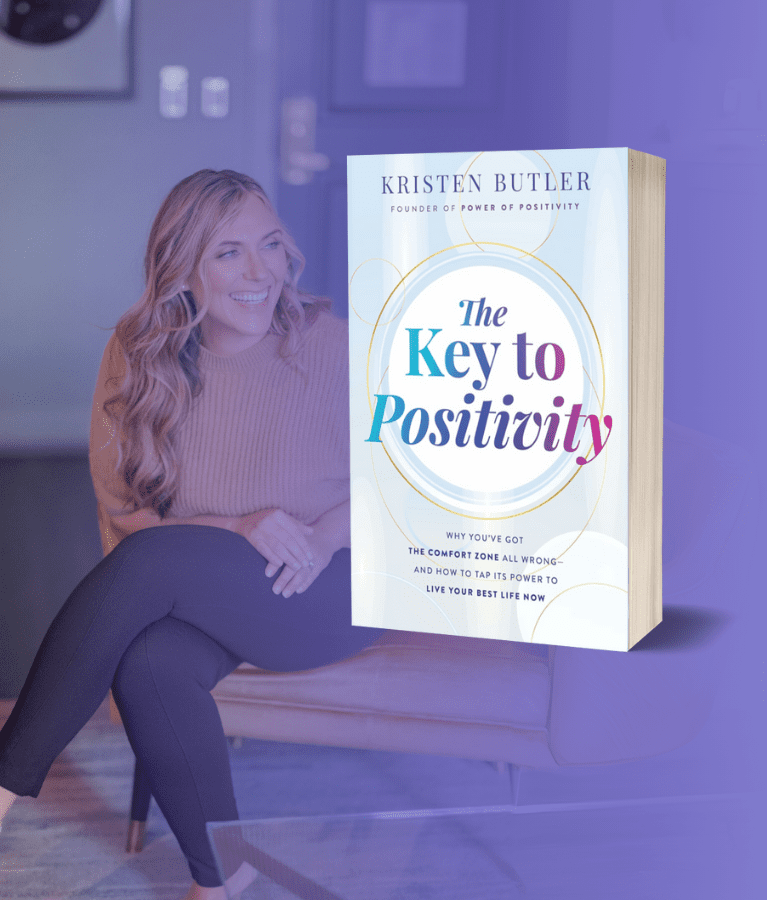Learn how growth and gratitude lead to a joyful life.
In our pursuit of happiness and personal fulfillment, positivity isn’t just a fleeting state of mind. Instead, it’s a never-ending journey of gratitude and growth that unfolds throughout our lives. Common wisdom often tells us that to grow, we must each step outside our comfort zone to be happier. However, I take a transformative approach in my new book, The Key to Positivity, turning this old trope on its head.
I show you how real, sustainable growth is not about abandoning our comfort zones but expanding them from the gratitude within.
This shift in perspective suggests that the secret to lifelong happiness lies not in the relentless pursuit of the new and unknown by stepping into discomfort but by pulling new skills, attitudes, and ideas into our existing comfort zone. By doing so, we don’t just step out into the unknown. Rather, we extend the boundaries of our world and unlock new happiness. This approach challenges us to rethink how we perceive personal development and happiness, advocating for a balance that nurtures mental and physical well-being while encouraging gradual, meaningful growth.
Understanding the Key to Positivity
To fully grasp the innovative approach proposed in The Key to Positivity, it’s best to understand the three zones of personal growth: the comfort zone, survival zone, and complacent zone. Each of these zones represents a different way individuals approach their lives and challenges, and they play a crucial role in molding our experiences and overall happiness.
The Comfort Zone
Contrary to popular belief, the comfort zone isn’t a trap that stifles growth. Instead, it’s fertile ground for growing. The Key to Positivity reveals how growth can and should occur within your comfort level. We naturally extend our boundaries by integrating new skills, attitudes, and ideas into our comfort zones. Thus, we enrich our lives without the overwhelming stress accompanying stepping into the unknown.
This approach emphasizes the importance of psychological safety in personal development. We’re more likely to experiment and take calculated risks when we feel safe. We’re also more likely to embrace changes that can lead to growth and gratitude. It’s about making the unfamiliar familiar and the new less daunting, thus continuously expanding the horizons of our happiness.
For example, learning a new language before taking a dream vacation can happen in one’s comfort zone by practicing with familiar routines or environments. For instance, you can listen to audio lessons while commuting, reciting along as you drive. Or, you can dedicate just five minutes of focused time to the next grammar lesson.
This method ensures that we are not paralyzed by fear or anxiety, common feelings when one steps too far out of the comfort zone.
Because we have created an environment where new challenges are welcomed but not forced upon us, we create a sustainable model of growth that enhances our life satisfaction and overall well-being. This example is the essence of growing from within our comfort zone—a gentle yet effective expansion that brings about lasting gratitude and happiness. It’s where we feel safe and secure. It’s characterized by familiarity and ease, where anxiety and stress are minimal because we’re surrounded by what we know. This zone is not about stagnation; rather, it’s the foundation from which we can safely explore new ideas and challenges at a manageable pace.
The Survival Zone: Running on a Hamster Wheel
Often mistaken for the ideal environment for achievement and growth, the survival zone represents a dangerous state where individuals operate under constant stress and high pressure. It is aptly likened to running on a hamster wheel, where there is no real progress despite immense effort and speed—just endless toil and exhaustion.
People in the survival zone are typically overachievers who push themselves to their limits without taking time to recover or reflect. This relentless pursuit often leads to burnout and emotional, physical, and mental exhaustion. It comes from excessive and prolonged stress. While this zone may foster rapid development and success, it often diminishes productivity, creativity, and gratitude.
The key issue with the survival zone is the stress it induces and its misalignment with sustainable growth. True growth requires balance—a harmony between challenge and recovery. Operating in survival mode means missing out on crucial opportunities for reflection and learning, vital for effectively integrating new skills and knowledge.
Recognizing the signs of being in the survival zone is the first step towards shifting towards a more balanced approach. These signs may include constant fatigue, irritability, and a sense of stagnation. If you find yourself in this zone, it’s important to take a step back and reassess your priorities. Instead of glorifying the grind, it’s healthier and more productive to nurture a lifestyle that allows for challenges within the bounds of what can be handled without jeopardizing your health and happiness. This shift enhances personal growth and ensures that it is sustainable and enjoyable.
The Complacent Zone: Stagnation and Jealousy While Stuck in One Place
The complacent zone is marked by inertia—an absence of growth and the reluctance to embrace new challenges or change. Individuals in this zone are often characterized by a sense of contentment with the status quo, regardless of whether it contributes positively to their personal or professional lives. This stagnation can lead to feelings of jealousy towards those who continue to develop and achieve, further entrenching the inertia.
People who remain complacent often miss out on the joys and benefits of personal development. They may watch others move forward and expand their horizons, fostering resentment and a sense of inadequacy. This negative emotional cycle makes breaking free from the complacent zone even more difficult, as jealousy and resentment build barriers to taking the initiative for change. They lack gratitude for what they do have and are jealous of what they have not.
To move out of this zone, individuals need to recognize the value of growth and its positive impact on their lives. It’s about shifting perspective from viewing change as a threat to seeing it as a welcome opportunity. It requires cultivating an attitude that accepts minor adjustments and celebrates small victories, which can gradually lead to more significant transformations.
By challenging oneself to step just slightly outside the familiar while still within the bounds of comfort, one can begin to dismantle complacency. That doesn’t mean making drastic changes that could push someone into the survival zone but rather making manageable adjustments that encourage growth without overwhelming stress.
Breaking free from the complacent zone is not just a necessary step; it’s a liberating one. It’s about fostering a fulfilling life filled with continuous learning and personal satisfaction. It’s about turning envy into inspiration and inaction into movement, one small step at a time.

Strategies for Using the Key to Positivity in Your Daily Routine
Expanding your comfort zone doesn’t require drastic leaps into unknown territories; it involves incremental steps that gradually integrate new experiences and challenges. This sustainable approach ensures that growth is manageable and enjoyable, allowing for a deeper and more meaningful development. Here are several strategies to help you gently expand your comfort zone:
- Start Small: Choose small challenges that feel slightly uncomfortable but not overwhelming. These could be as simple as taking a different route to work, listening to a new educational podcast, or conversing with a colleague you haven’t spoken to much. Small victories build confidence and set you up for more significant challenges.
- Increase Exposure Gradually: If there’s a particular area you wish to improve or explore, increase your exposure to it gradually. For example, if public speaking makes you anxious, start speaking in smaller, more informal settings. Later, you can try moving on to larger, more formal events. This gradual exposure reduces anxiety and builds familiarity.
- Focus on Learning, Not Performance: Shift your mindset from a performance-based approach, where the pressure to excel can be paralyzing, to a learning-based approach, which encourages curiosity and exploration without the fear of failure. This shift helps integrate new skills and experiences more comfortably.
- Seek Feedback: Constructive feedback can be a valuable tool for growth. It provides insights into areas of improvement and tailors your approach to expanding your comfort zone. Feedback should be sought from trusted peers or mentors who understand your goals and are invested in your growth.
- Reflect Regularly: Regular reflection on your experiences and feelings as you try new things is crucial. It helps you understand what works, what doesn’t, and how far you’ve come in expanding your comfort zone. Journaling can be an effective method for this reflection.
- Celebrate Progress: Recognize and celebrate wins, no matter how small. You will boost your morale and reinforce the positive gains you have made.
By implementing these strategies, you’ll find that your comfort zone naturally expands. You’ll be able to embrace new challenges with less anxiety and more confidence, leading to continuous and sustainable personal growth.
Building a Positive Mindset With the Key to Positivity
Cultivating a grateful, positive mindset is crucial for lifelong growth and happiness. Gratitude makes challenges seem more manageable and enhances your overall satisfaction with life. Here are some key ways to foster a mindset that supports positivity and growth:
- Practice Gratitude: Start or end each day by acknowledging things you are thankful for. Gratitude shifts your focus from what’s missing or problematic to what’s abundant and right in your life. That results in reducing negativity and boosting your mood.
- Embrace Optimism: Try to see the opportunity in every challenge. An optimistic outlook helps you anticipate the best possible outcomes, making you more resilient against fear and discouragement when facing new experiences.
- Set Realistic Expectations: While it’s important to aim high, setting achievable goals can prevent feelings of disappointment and inadequacy. Ensure that your expectations align with your current abilities and resources, and adjust them as you grow and learn.
- Maintain a Growth Mindset: Embrace the belief that your abilities and intelligence come from dedication and hard work. A growth mindset encourages perseverance and effort, which are critical in overcoming obstacles and succeeding in new ventures.
- Cultivate Self-Compassion: Be kind to yourself, especially when unplanned roadblocks occur. Self-compassion means treating yourself with the kindness you’d offer a friend in the same situation.
- Surround Yourself with Positivity: Engage with supportive and optimistic people who encourage your growth and value your well-being. Their positive energy can influence your attitudes and behaviors.
- Reflect on Positive Experiences: Regularly reflect on experiences that have brought you joy and satisfaction. This reflection enhances your mood and reinforces the benefits of intentionally applying the key to positivity in your life.
As you work on these small steps, you begin to have a more grateful and happy mindset to support your efforts to grow in happiness. Watch and see!
Final Thoughts on Using the Key to Positivity to Unlock Happiness
Understanding and nurturing the space where you feel comfortable is crucial for lifelong happiness and growth. “The Key to Positivity“ reframes the traditional notion that growth only occurs outside our comfort zones. Instead, it proposes that true, sustainable development happens when we expand our comfort zones from within.
Give these strategies a try! You’ll see how a little effort brings new challenges and experiences into your life in a manageable way. You will also retain a feeling of safety, foundational for real and lasting change.
We’ve explored how escaping the extremes of the survival and complacent zones and focusing on expanding the comfort zone can help you be happy. But remember that growth is a personal and unique experience. What works for one may not work for another. The key is to find your rhythm and pace and to embrace the process of expanding your comfort zone at a rate that feels right for you. By doing so, you’ll discover that the key to positivity and lifelong happiness isn’t about reaching a destination. Rather, it means enjoying the journey of continuous self-discovery and development.
Embrace the lessons from my new book, The Key to Positivity, and let them guide you through a life of gratitude and enduring happiness. Here’s to unlocking your potential and expanding your world from a place of comfort and confidence. Shine on!




















